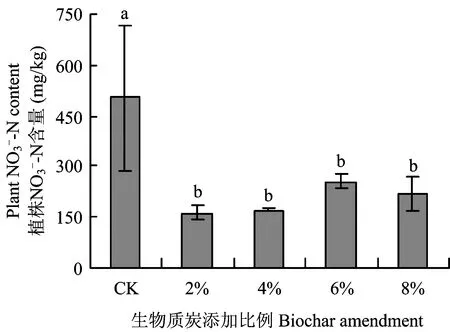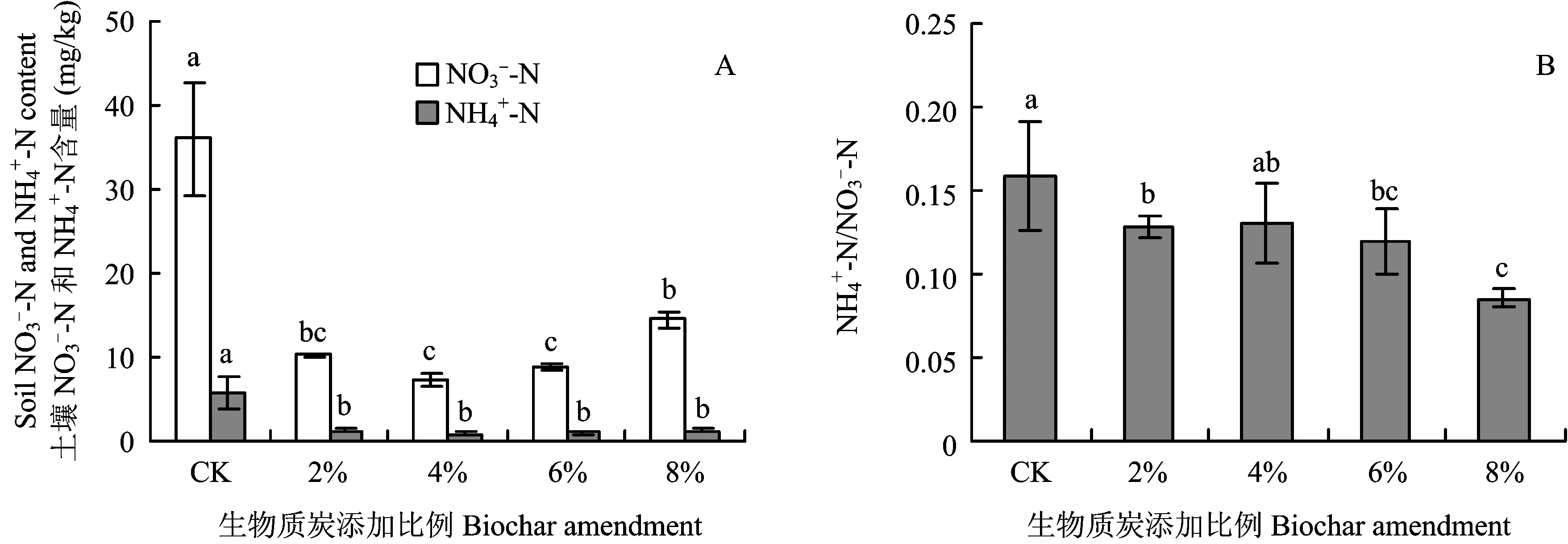城市园林废弃物生物质炭对小白菜生长、硝酸盐含量及氮素利用率的影响
2014-04-09张登晓周惠民潘根兴李恋卿郑金伟
张登晓, 周惠民, 潘根兴, 李恋卿, 郑金伟
(南京农业大学农业资源与生态环境研究所, 江苏南京 210095)
蔬菜是日常摄取的主要食物。2008年我国蔬菜种植面积达到17.88百万公顷,已占我国耕地面积的11.4%[1]。2012年,我国温室大棚蔬菜的种植面积迅速增加,达到20.35百万公顷,成为世界上最大的温室蔬菜生产国[1-3]。与传统露天栽培方式相比,温室蔬菜产量得到大幅提高,但同时氮肥投入量大幅增加[4]。据统计,山东省温室大棚系统中氮肥的使用量高达N 4000 kg/hm2,而过量施肥一方面导致肥料利用率降低[4-5],部分地区氮肥利用率甚至不足10%[6-8];另一方面导致蔬菜硝酸盐积累[9]和土壤硝态氮积累[8,10],进而导致地表水和地下水的富营养化[11]并诱发土壤盐渍化[12]。研究显示,蔬菜中具有高硝酸盐含量[13],尤其叶菜类蔬菜具有更高的硝酸盐积累[14-15]。硝酸盐在人体内可转化为具有致癌作用的亚硝酸盐,而人体摄入的大部分硝酸盐来自蔬菜[16]。因此,控制蔬菜硝酸盐积累,提高氮素利用率是温室蔬菜种植中需要关注的问题。生物质炭由于具有很强的吸附性能,能够减少肥料的渗漏损失,提高肥料利用率[17-19],并且对作物产量具有促进作用[20]。以往研究大多采用秸秆生物质炭,并且以农田施用为主,在温室蔬菜生产中的应用研究较少。城市园林废弃物生物质炭对温室蔬菜产量和品质的影响以及对设施农业氮素利用率的影响还没有清楚认识。为此,本研究以温室小白菜为研究对象,采用盆栽试验方法,研究土壤添加生物质炭对温室蔬菜产量和品质,以及养分的保持效应的影响,以求探索一种绿色环保的现代农业模式。
1 材料与方法
1.1 试验材料


表1 土壤和生物质炭的基本理化性状
1.2 试验设计
本试验采用单因素(生物质炭)试验设计,5个用量水平,即不施生物质炭(对照)和施用生物质炭(烘干重)20、 40、 60及80 g/kg的处理,分别标为C0,C1,C2,C3及 C4。盆栽土壤每盆2 kg(干重计),施肥为N 150 mg/kg和P2O533 mg/kg,分别施入尿素和过磷酸钙基肥,不施追肥。因生物质炭含有较高的钾素含量,施肥中不考虑钾肥。

本试验在南京农业大学资环学院温室大棚中进行,于2012年4月7日播种。每个处理设三次重复,随机排列放置,且每天补水后随机调整摆放位置。
1.3 分析项目和方法
小白菜生物量测定:收获时沿盆内土壤表面剪下地上部,用自来水冲洗粘附土粒,继之用蒸馏水冲洗,吸干水分后称取鲜重。将盆内根系取出,并用水冲洗土粒,继之用蒸馏水洗净。
植物样品置于烘箱,105℃下杀青半小时后,65℃烘干到恒重。分别得到地上部和地下部干重。

土壤性质测定:按鲍士旦(2000)推荐方法[22],其中pH采用土水比(w ∶w)为1 ∶2.5,生物质炭 ∶水(w ∶w)为1 ∶10;采用半微量开氏法测定土壤全氮;取盆栽鲜土过2 mm筛,采用2 mol/L KCl浸提,其中铵态氮采用靛酚蓝比色法测定,而硝态氮采用双波长比色法测定[23]。
1.4 数据处理
计算了如下几个指标:1)收获指数(Harvest index)为每盆地上部干重(g)除以地上部和地下部干重总和(g)得到;2)氮素损失率(N loss rate)为作物种植后土壤氮素损失量占种植前土壤全氮量的百分比;(3)土壤氮素生产率(N Productivity)为试验条件下每克氮素得到的地上部生物量鲜重克数,由地上部生物量鲜重除以播种前土壤总氮得到,单位g/g。
所有试验数据和图表采用Microsoft Excel 2007处理。不同处理间差异采取SPSS16.0进行单因素方差分析,LSD法进行显著性检验(P<0.05)。测定结果数据均以平均值±标准差的形式表示。
2 结果与分析
2.1 生物质炭对小白菜产量的影响
不同用量生物质炭添加对小白菜产量的影响见表2。与对照相比,生物质炭添加下地上部产量均显著提高,C1、 C2、 C3和C4处理下增产幅度分别达到49.5%、 62.8%、 77.8% 和74.4%。其中,C3和C4处理下增产幅度达到75%,增产效应十分显著。


表2 生物质炭施用下小白菜产量、 生物量、 收获指数和叶面积
2.2 生物质炭对小白菜硝酸盐含量的影响


图1 不同生物质炭处理小白菜叶片中含量 contents in leaves of Brassica chinensis Linn under biochar additions
2.3 生物质炭对植株氮素利用的影响

3 讨论与结论
本研究表明,温室大棚栽培小白菜的土壤中加入不同量的生物质炭能提高小白菜产量,并且产量与生物质炭的添加量呈正相关关系(P<0.05)(表4),表明生物质炭对蔬菜生长具有显著的促进作用。

表3 不同比例生物质炭处理对氮素保持效应及土壤氮素生产率的影响

图2 生物质炭处理下土壤含量(A)和铵硝比(B)的变化Fig.2 Soil contents (A) and ratio(B) under the biochar amendments
生物质炭提高大田粮食作物产量已经在很多研究中有所报道[24-27]。也有研究表明了生物质炭对菠菜[28]、 辣椒[29]等蔬菜具有不同幅度的增产作用。本研究结果看,添加生物质炭能够增加植株生物量,同时降低了根冠比而提高了蔬菜收获指数。根冠比主要反映地上部和根系之间对光合产物的分配状况[30],它与土壤中氮素的含量有关,Reich[31]发现施肥减少了生物量向根系的分配。在一定氮素范围内,根冠比在低氮条件下高于高氮条件[30,32]。Spokas[33]发现生物质炭加入土壤中导致植物体内乙烯含量的增加,这可能是促进植物地上部生长的原因之一[33]。但是,生物质炭添加是否影响了土壤生物学性质,进而影响了蔬菜的产量性能还不清楚。
本试验还表明,蔬菜植株硝酸盐含量与土壤中铵态氮和硝态氮含量具有相关性,但与土壤全氮含量相关性不显著(表4)。不同用量下植株硝酸盐含量降低幅度在50%以上,特别是2%生物质炭土壤添加降低硝酸盐含量的幅度达到68%。
在本试验中,土壤全氮含量与生物质炭添加量存在显著的相关性,但与土壤中铵态氮和硝态氮含量不具相关性(表4)。与降低蔬菜硝酸盐含量类似,生物质炭降低了土壤硝态氮和铵态氮含量。氮素平衡分析表明,添加生物质炭显著降低氮素损失率42%以上,提高土壤氮素生产率超过35%。这一方面可能是由于添加生物质炭降低了氮素N2O排放损失。土壤中氨硝含量的降低可能与生物质炭降低农田土壤中碳氮的矿化有关[34-36]。生物质炭通过改善土壤通气状况从而抑制了氮素在硝化和反硝化过程中N2O的形成和排放[27,37]。同时,研究指出生物质炭可减低土壤溶液中的氨浓度,从而降低氮素以氨气形式的挥发[37-38]。另外,生物质炭颗粒具有较大的阳离子吸附量,有多孔性和高比表面积等特性[39-40],化肥氮素特别是铵离子易被吸附进而与生物质炭复合而达到缓释的作用,从而促进植物持续吸收利用。

表4 各调查指标间的相关性

参考文献:
[1] 中国统计局. 中国统计年鉴(2009-2013)[M]. 北京:中国统计局.
Chinese Statistical Bureau. China statistical year book (2009-2013)[M]. Beijing:Chinese Statistical Bureau.
[2] Chang J, Wu X, Liu Aetal. Assessment of net ecosystem services of plastic greenhouse vegetable cultivation in China[J]. Ecological Economics, 2011, 70(4):740-748.
[3] Chen Y, Huang B, Hu Wetal. Environmental assessment of closed greenhouse vegetable production system in Nanjing, China[J]. Journal of Soils and Sediments, 2013, 13:1418-1429.
[4] Guo J H, Liu X J, Zhang Yetal. Significant acidification in major Chinese croplands[J]. Science, 2010, 327(5968):1008-1010.
[5] 张福锁, 王激清, 张卫峰, 等. 中国主要粮食作物肥料利用率现状与提高途径[J]. 土壤学报, 2008, 45(5):915-924.
Zhang F S, Wang J Q, Zhang W Fetal. Nutrient use efficiencies of major cereal crop in China and measures for improvement[J]. Acta Pedologica Sinica, 2008, 45(5):915-924.
[6] Zhu J H, Li X L, Christie P, Li J L. Environmental implications of low nitrogen use efficiency in excessively fertilized hot pepper (CapsicumfrutescensL.) cropping systems[J]. Agriculture, Ecosystems & Environment, 2005, 111:70-80.
[7] Ju X T, Kou C L, Christie Petal. Changes in the soil environment from excessive application of fertilizers and manures to two contrasting intensive cropping systems on the North China Plain[J]. Environmental Pollution, 2007, 145(2):497-506.
[8] Min J, Zhao X, Shi W Metal. Nitrogen balance and loss in a greenhouse vegetable system in Southeastern China[J]. Pedosphere, 2011, 21(4):464-472.
[9] Zhou Z Y, Wang M J, Wang J S. Nitrate and nitrite contamination in vegetables in China[J]. Food Reviews International, 2000, 16(1):61-76.
[10] Min J, Shi W, Xing Getal. Effects of a catch crop and reduced nitrogen fertilization on nitrogen leaching in greenhouse vegetable production systems[J]. Nutrient Cycling in Agroecosystems, 2011, 91:31-39.
[11] Constantin J, Mary B, Laurent Fetal. Effects of catch crops, no till and reduced nitrogen fertilization on nitrogen leaching and balance in three long-term experiments[J]. Agriculture, Ecosystems & Environment, 2010, 135(4):268-278.
[12] Shi W M, Yao J, Yan F. Vegetable cultivation under greenhouse conditions leads to rapid accumulation of nutrients, acidification and salinity of soils and groundwater contamination in South-Eastern China[J]. Nutrient Cycling in Agroecosystems, 2009, 83:73-84.
[13] Santamaria P. Nitrate in vegetables:toxicity, content, intake and EC regulation[J]. Journal of the Science of Food and Agriculture, 2006, 86(1):10-17.
[14] 都韶婷, 金崇伟, 章永松. 蔬菜硝酸盐积累现状及其调控措施研究进展[J]. 中国农业科学, 2010, 43(17):3580-3589.
Du S T, Jin C W, Zhang Y S. Current situations and research progress of nitrate pollution in vegetables and their regulating strategies[J]. Scientia Agriculturae Sinica, 2010, 43(17):3580-3589.
[15] Authority E F S. Nitrate in vegetables:scientific opinion of the panel on contaminants in the food chain[J]. The EFSA Journal, 2008, 689:1-79.
[16] 刘永刚, 陈利军, 武志杰. 蔬菜中硝酸盐的积累机制及其调控措施[J]. 土壤通报, 2006, 37(3):612-616.
Liu Y G, Chen L J, Wu Z Jetal. Accumulation mechanisms of nitrate in vegetables and their regulation[J]. Chinese Journal of Soil Science, 2006, 37(3):612-616.
[17] Glaser B, Lehmann J, Zech W. Ameliorating physical and chemical properties of highly weathered soils in the tropics with charcoal-a review[J]. Biology and Fertility of Soils, 2002, 35(4):219-230.
[18] Isobe T. Suppression of nitrogen outflow from bedding plants soil by zeolite or charcoal[J]. Horticultural Research(Japan), 2002, 1:45-48.
[19] 曲晶晶, 郑金伟, 郑聚锋, 等. 小麦秸秆生物质炭对水稻产量及晚稻氮素利用率的影响[J]. 生态与农村环境学报, 2012, 28(3):288-293.
Qu J J, Zheng J W, Zheng J Fetal. Effects of Wheat-Straw-Based Biochar on Yield of Rice and Nitrogen Use Efficiency of Late Rice[J]. Journal of Ecology and Rural Environment, 2012, 28(3):288-293
[20] Atkinson C J, Fitzgerald J D, Hipps N A. Potential mechanisms for achieving agricultural benefits from biochar application to temperate soils:a review[J]. Plant and Soil, 2010, 337:1-18.
[21] 王学奎. 植物生理生化实验原理和技术(第二版)[M]. 北京:高等教育出版社, 2006. 122-123.
Wang X K. Experimental principle and technipue for plant physiology and biochemistry[M]. Beijing:Higher Education Press, 2006. 122-123.
[22] 鲍士旦. 土壤农化分析(第三版)[M]. 北京:中国农业出版社, 2000.
Bao S D. Soil and Agro-chemistry Analysis(3rd Ed.)[M]. Beijing:China Agricultural Press, 2000.
[23] 国家环境保护总局. 水和废水监测分析方法(第四版)[M]. 北京:中国环境科学出版社, 2002. 266-268.
State Environmental Protection Administration. Analysis methods for water and wastewater (4th edition)[M]. Beijing:China Environmental Science Press, 2002. 266-268.
[24] Asai H, Samson B K, Stephan H Metal. Biochar amendment techniques for upland rice production in Northern Laos:1. Soil physical properties, leaf SPAD and grain yield[J]. Field Crops Research, 2009, 111:81-84.
[25] Major J, Rondon M, Molina Detal. Maize yield and nutrition during 4 years after biochar application to a Colombian savanna oxisol[J]. Plant and Soil, 2010, 333:117-128.
[26] Haefele S M, Konboon Y, Wongboon Wetal. Effects and fate of biochar from rice residues in rice-based systems[J]. Field Crops Research, 2011, 121(3):430-440.
[27] Zhang A, Liu Y, Pan Getal. Effect of biochar amendment on maize yield and greenhouse gas emissions from a soil organic carbon poor calcareous loamy soil from Central China Plain[J]. Plant and Soil, 2012, 351(1-2):263-275.
[28] 张万杰, 李志芳, 张庆忠, 等. 生物质炭和氮肥配施对菠菜产量和硝酸盐含量的影响[J]. 农业环境科学学报, 2011, 30(10):1946-1952.
Zhang W J, Li Z F, Zhang Q Zetal. Impacts of biochar and nitrogen fertilizer on spinach yield and tissue nitrate content from a pot experiment[J]. Journal of Agro-Environment Science. 2011, 30(10):1946-1952.
[29] Pudasaini K, Ashwath N, Walsh K, Bhattarai T. Biochar Improves Plant Growth and Reduces Nutrient Leaching in Red Clay Loam and Sandy Loam[J]. Hydro Nepal:Journal of Water, Energy and Environment, 2012, 11(1):86-90.
[30] 姜琳琳, 韩立思, 韩晓日, 等. 氮素对玉米幼苗生长, 根系形态及氮素吸收利用效率的影响[J]. 植物营养与肥料学报, 2011, 17(1):247-253.
Jiang L l, Han L S, Han X Retal. Effects of nitrogen on growth, root morphological traits, nitrogen uptake and utilization efficiency of maize seedlings[J]. Plant Nutrition and Fertilizer Science, 2011, 17(1):247-253.
[31] Reich P. Root-shoot relations:optimality in acclimation and adaptation or the “Emperor’s new clothes”[A]. Waisel Y, Eshel A, Kafkafi U. Plant roots, the hidden half[C]. New York:Marcel Dekker, 2002. 205-220.
[32] Vamerali T, Saccomani M, Bona Setal. A comparison of root characteristics in relation to nutrient and water stress in two maize hybrids[J]. Plant Soil, 2003, 255:157-167.
[33] Spokas K A, Baker J M, Reicosky D C. Ethylene:Potential key for biochar amendment impacts[J]. Plant and Soil, 2010, 333:443-452.
[34] Kuzyakov Y, Subbotina I, Chen Hetal. Black carbon decomposition and incorporation into soil microbial biomass estimated by14C labeling[J]. Soil Biology and Biochemistry, 2009, 41(2):210-219
[35] Jones D L, Murphy D V, Khalid Metal. Short-term biochar-induced increase in soil CO2release is both biotically and abiotically mediated[J]. Soil Biology and Biochemistry, 2011, 43(8):1723-1731.
[36] Dempster D N, Gleeson D B, Solaiman Z Metal. Decreased soil microbial biomass and nitrogen mineralisation with Eucalyptus biochar addition to a coarse textured soil[J]. Plant and Soil, 2012, 354:311-324.
[37] Lehmann J, Gaunt J, Rondon M. Bio-char sequestration in terrestrial ecosystems-a review[J]. Mitigation and Adaptation Strategies for Global Change, 2006, 11(2):395-419.
[38] Taghizadeh-Toosi A, Clough T J, Sherlock R R, Condron L M. A wood based low-temperature biochar captures NH3-N generated from ruminant urine-N, retaining its bioavailability[J]. Plant and Soil, 2012, 353:73-84.
[39] Lehmann J, Joseph S. Biochar for environmental management:science and technology[M]. London, UK:Earthscan, 2009. 1-29,107-157.
[40] 刘莹莹, 秦海芝, 李恋卿, 潘根兴, 等. 不同作物原料热裂解生物质炭对溶液中Cd2+和Pb2+的吸附特征[J]. 生态环境学报, 2012, 21(1):146-152.
Liu Y Y, Qin H Z, Li L Q, Pan G Xetal. Adsorption of Cd2+and Pb2+in aqueous solution by biochars produced from the pyrolysis of different crop feedstock[J]. Ecology and Environmental Sciences, 2012, 21(1):146-152.
